Some vocabulary, helpful for reading descriptions of pathology:
- Parenchyma and stroma are convenient terms to distinguish between principal tissue components of an organ:
- Parenchyma refers to the distinctive cell types which conduct the specific function of an organ, or the distinctive cell types which characterize a tumor.
- Stroma is tissue which supports the parenchyma -- connective tissue, blood vessels, nerves.
- Inflammation is a fundamental mechanism of tissue defense.
Inflammation accompanies many different types of tissue disturbance.
The suffix "-itis" indicates inflammation.
- Metaplasia is replacement of differentiated cells within a tissue by differentiated cells of a different type.
- Dysplasia is disordered growth of a tissue.
Dysplasia is commonly a prelude to malignant neoplasm.
- Neoplasia literally means "new growth."
The suffix "-oma" commonly indicates a neoplastic growth, or "tumor."
Neoplasms may be:- benign -- confined in location,
- malignant -- invading into surrounding tissue
- metastatic -- disseminating to distant locations.
- A "carcinoma" is a malignant neoplasm of epithelial origin.
- An "adenoma" is a tumor of glandular origin.
- Scarring is replacement of damaged tissue by collagen.
- Fibrosis is a more general term, indicating excess deposition of collagen for any reason.
- (The terms above are far from a complete list of histopathology vocabulary.)
Illustrative examples
Each example below includes both an image of normal histology and a link to a WebPath image from a similar anatomical location, illustrating pathologically altered histology.
The WebPath links will take you to pages at WebPath's General Pathology or Systemic Pathology collections. In addition to a micrograph of the pathology, each of these links offers a brief description of the illustrated pathology as well as further links to related WebPath resources.
NOTE: These examples are intended for beginners. Many of WebPath links include pathological tissue alongside normal within the same image, so that the difference should be apparent even if you have not yet learned much about normal tissue appearance.
Special instructions for viewing these examples:
Once opened, each WebPath page will easily link to related WebPath examples.
[presuming your computer monitor has sufficient width].
Example 01
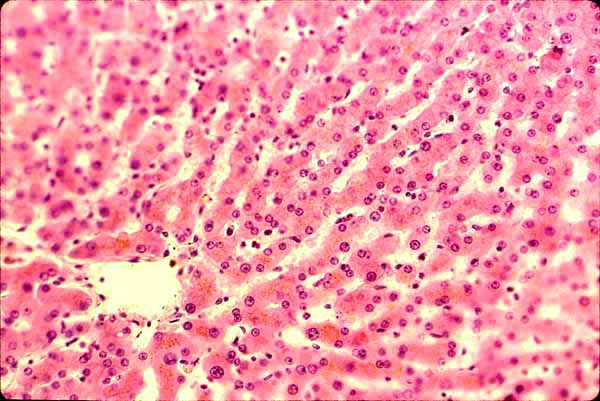 |
Image above: Normal liver parenchyma WebPath example: Malignant neoplasm in liver. [Link opens in new tab.] |
REMINDER: Close tab for WebPath example.
TOP OF PAGE / INDEX OF EXAMPLES / BASIC VOCABULARY
Example 02
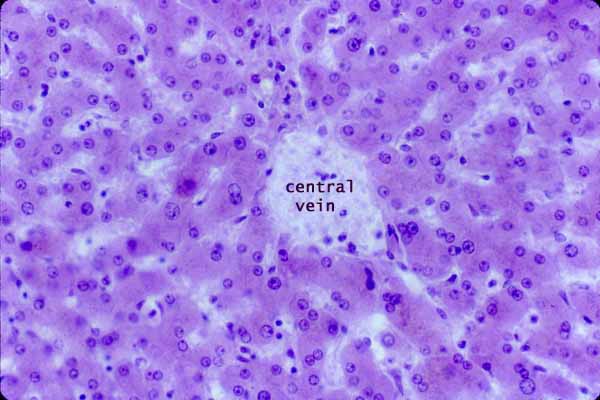 |
Image above: Normal liver parenchyma WebPath example: Hepatitis. [Link opens in new tab.] |
REMINDER: Close tab for WebPath example.
TOP OF PAGE / INDEX OF EXAMPLES / BASIC VOCABULARY
Example 03
 |
Image above: Normal liver parenchyma (low magnification) WebPath example: Cirrhosis (scarring of liver). [Link opens in new tab.] |
REMINDER: Close tab for WebPath example.
TOP OF PAGE / INDEX OF EXAMPLES / BASIC VOCABULARY
Example 04
 |
Image above: Normal liver parenchyma WebPath example: Malignant neoplasm in liver. [Link opens in new tab.] |
REMINDER: Close tab for WebPath example.
TOP OF PAGE / INDEX OF EXAMPLES / BASIC VOCABULARY
Example 05
 |
Image above: Normal liver parenchyma WebPath example: Malignant neoplasm in liver. [Link opens in new tab.] |
REMINDER: Close tab for WebPath example.
TOP OF PAGE / INDEX OF EXAMPLES / BASIC VOCABULARY
Example 06
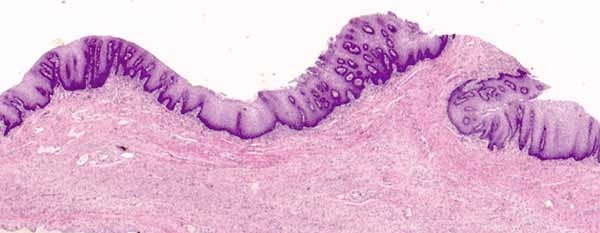 |
Image above: Normal vagina (cervical epithelium is similar) WebPath example: Chronic cervicitis. [Link opens in new tab.] |
REMINDER: Close tab for WebPath example.
TOP OF PAGE / INDEX OF EXAMPLES / BASIC VOCABULARY
Example 07
 |
Image above: Normal vagina (cervical epithelium is similar) WebPath example: Cervical dysplasia. [Link opens in new tab.] |
REMINDER: Close tab for WebPath example.
TOP OF PAGE / INDEX OF EXAMPLES / BASIC VOCABULARY
Example 08
 |
Image above: Normal vagina (cervical epithelium is similar) WebPath example: Cervical dysplasia with inflammation. [Link opens in new tab.] |
REMINDER: Close tab for WebPath example.
TOP OF PAGE / INDEX OF EXAMPLES / BASIC VOCABULARY
Example 09
 |
Image above: Normal salivary gland WebPath example: Inflammation and fibrosis of salivary gland. [Link opens in new tab.] |
REMINDER: Close tab for WebPath example.
TOP OF PAGE / INDEX OF EXAMPLES / BASIC VOCABULARY
Example 10
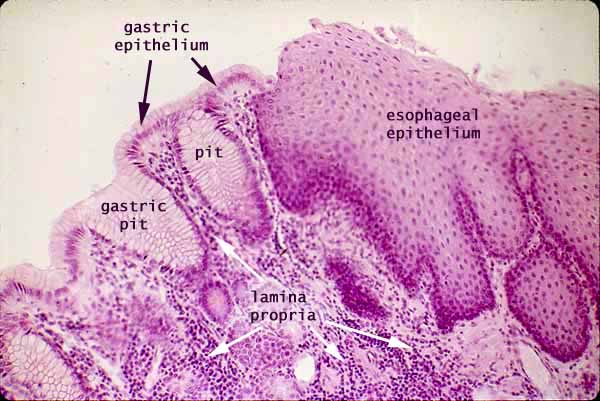 |
Image above: Normal gastro-esophageal junction WebPath example: Esophageal metaplasia (Barrett's esophagus). [Link opens in new tab.] |
REMINDER: Close tab for WebPath example.
TOP OF PAGE / INDEX OF EXAMPLES / BASIC VOCABULARY
Example 11
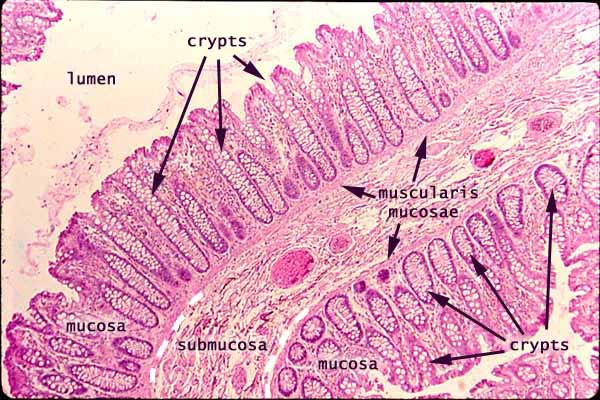 |
Image above: Normal colon mucosa WebPath example: Adenomatous polyp in colon. [Link opens in new tab.] |
REMINDER: Close tab for WebPath example.
TOP OF PAGE / INDEX OF EXAMPLES / BASIC VOCABULARY
Example 12
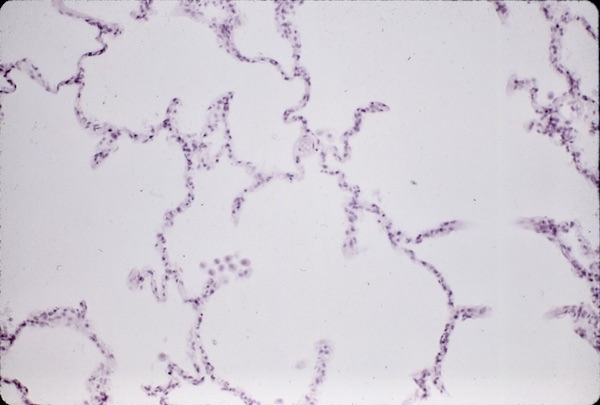 |
Image above: Normal lung alveoli WebPath example: Pneumonia. [Link opens in new tab.] |
REMINDER: Close tab for WebPath example.
TOP OF PAGE / INDEX OF EXAMPLES / BASIC VOCABULARY
Example 13
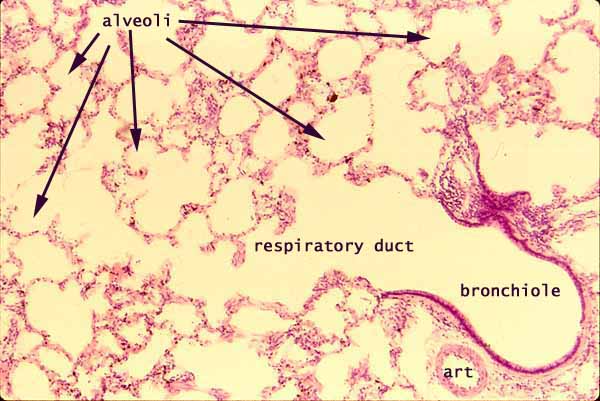 |
Image above: Normal lung alveoli WebPath example: Pneumonia. [Link opens in new tab.] |
REMINDER: Close tab for WebPath example.
TOP OF PAGE / INDEX OF EXAMPLES / BASIC VOCABULARY
Example 14
 |
Image above: Normal lung alveoli WebPath example: Metastasis of breast cancer into lung. [Link opens in new tab.] |
REMINDER: Close tab for WebPath example.
TOP OF PAGE / INDEX OF EXAMPLES / BASIC VOCABULARY
Example 15
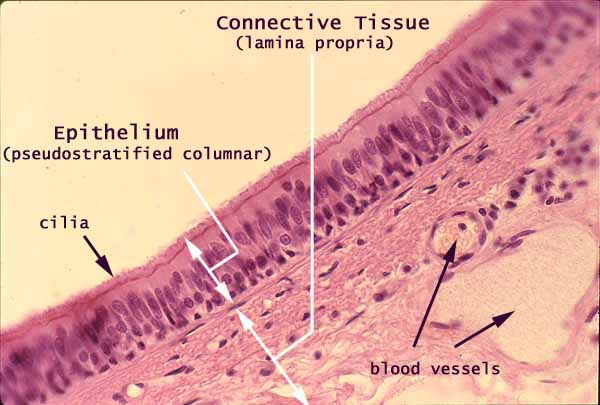 |
Image above: Normal respiratory epithelium WebPath example: Anaphylaxis (allergic response) in nasal mucosa.
[Link opens in new tab.] |
REMINDER: Close tab for WebPath example.
TOP OF PAGE / INDEX OF EXAMPLES / BASIC VOCABULARY
Example 16
 |
Image above: Normal respiratory epithelium WebPath example: Squamous metaplasia of larynx.
[Link opens in new tab.] |
REMINDER: Close tab for WebPath example.
TOP OF PAGE / INDEX OF EXAMPLES / BASIC VOCABULARY
Example 17
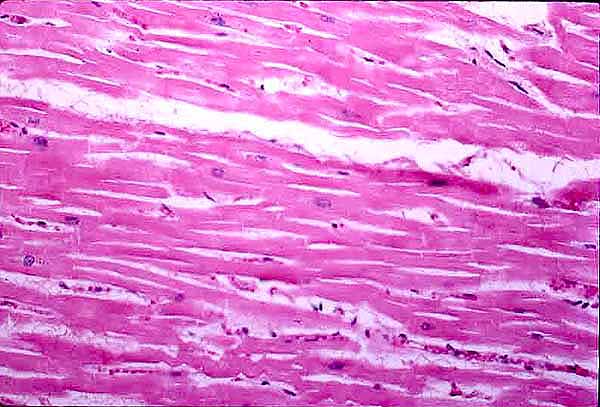 |
Image above: Normal cardiac muscle WebPath examples, Myocardial infarction [links open in new tabs]:
|
REMINDER: Close tab for WebPath examples.
TOP OF PAGE / INDEX OF EXAMPLES / BASIC VOCABULARY
Example 18
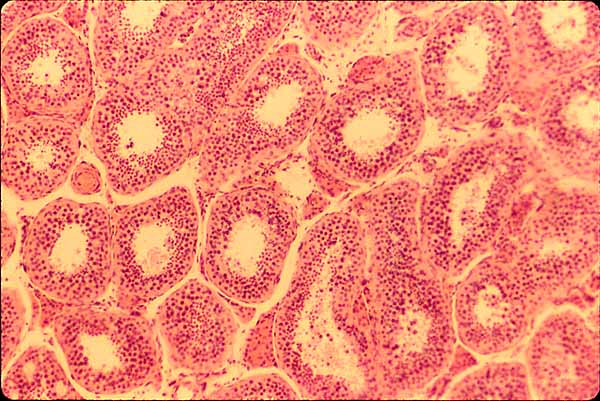 |
Image above: Normal seminiferous tubules of testis WebPath example: Seminoma.
[Link opens in new tab.] |
REMINDER: Close tab for WebPath example.
TOP OF PAGE / INDEX OF EXAMPLES / BASIC VOCABULARY
Example 19
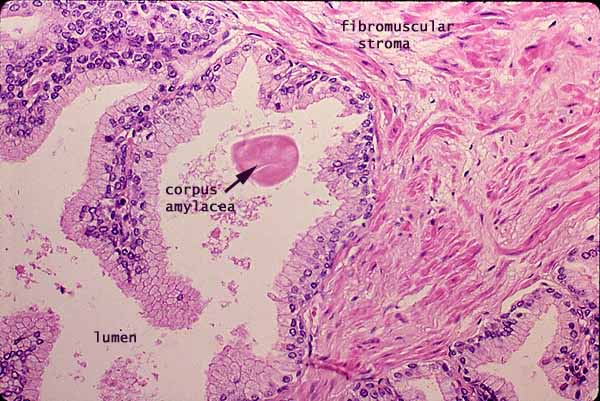 |
Image above: Normal prostate WebPath example: Chronic prostatitis.
[Link opens in new tab.] |
REMINDER: Close tab for WebPath example.
TOP OF PAGE / INDEX OF EXAMPLES / BASIC VOCABULARY
Example 20
 |
Image above: Normal prostate gland. Arrangement of glandular tubules is extremely various in normal prostate, depending on just where the sample is taken; compare with example 21 below. WebPath example: Adenocarcinoma of prostate.
[Link opens in new tab.] |
REMINDER: Close tab for WebPath example.
TOP OF PAGE / INDEX OF EXAMPLES / BASIC VOCABULARY
Example 21
 |
Image above: Normal prostate gland WebPath example: Adenocarcinoma of prostate.
[Link opens in new tab.] |
REMINDER: Close tab for WebPath example.
TOP OF PAGE / INDEX OF EXAMPLES / BASIC VOCABULARY
Example 22
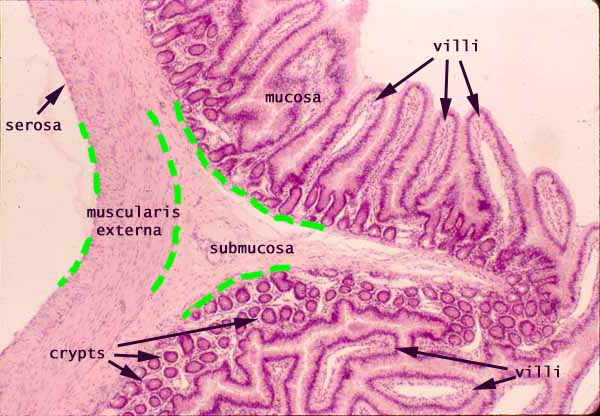 |
Image above: Small intestine Example from WikiMedia Commons: Endometriosis in muscularis of intestinal wall.
[Link opens in new tab.] |
REMINDER: Close tab for pathology example.
TOP OF PAGE / INDEX OF EXAMPLES / BASIC VOCABULARY
Example 23
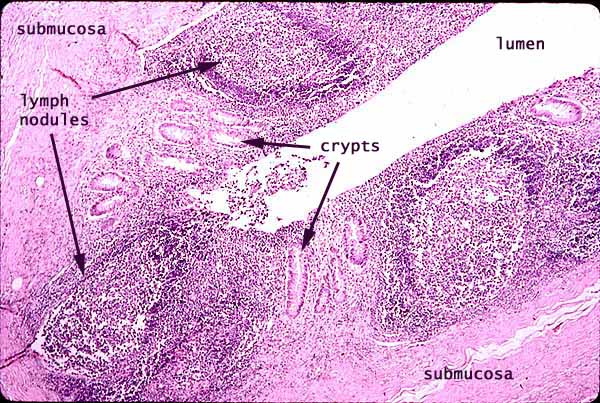 |
Image above: Normal (post-mortem) appendix WebPath example: Appendicitis.
[Link opens in new tab.] |
REMINDER: Close tab for WebPath example.
TOP OF PAGE / INDEX OF EXAMPLES / BASIC VOCABULARY
Example 24
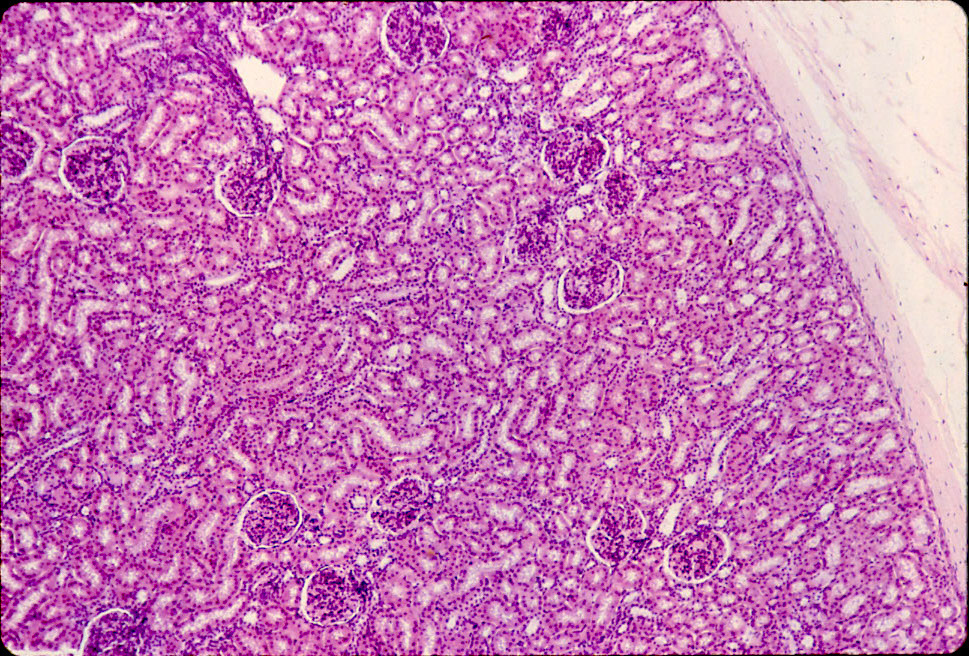 |
Image above: Normal renal cortex WebPath example: Acute renal infarct.
[Link opens in new tab.] |
REMINDER: Close tab for WebPath example.
TOP OF PAGE / INDEX OF EXAMPLES / BASIC VOCABULARY
Example 25
 |
Image above: normal renal cortex WebPath examples, Pyelonephritis [links open in new tabs]: |
REMINDER: Close tab for WebPath example.
TOP OF PAGE / INDEX OF EXAMPLES / BASIC VOCABULARY
SPACE FOR ADDITIONAL EXAMPLE
Example XX
 |
Image above: caption WebPath example: XXpathologytopicXX.
[Link opens in new tab.] |
REMINDER: Close tab for WebPath example.
TOP OF PAGE / INDEX OF EXAMPLES / BASIC VOCABULARY
External resources for histopathology
|
||||
TOP OF PAGE / INDEX OF EXAMPLES / BASIC VOCABULARY
List of WebPath pages linked in examples above.
01. Malignant neoplasm in liver (1).
02. Hepatitis.
03. Cirrhosis.
04. Malignant neoplasm in liver (2).
05. Malignant neoplasm in liver (3).
08. Cervical dysplasia with inflammation.
09. Salivary gland, inflammation with fibrosis.
11. Adenomatous polyp in colon.
12. Pneumonia (1).
13. Pneumonia (2).
14. Lung with metastasized breast carcinoma.
15. Anaphylaxis in nasal mucosa.
16. Squamous metaplasia of larynx.
20. Adenocarcinoma of prostate (low x).
21. Adenocarcinoma of prostate (high x).
22. Endometriosis in intestine.
23. Appendicitis.
24. Renal infarct.
